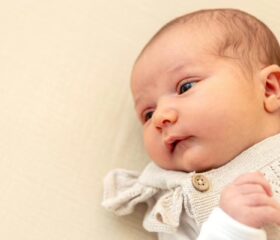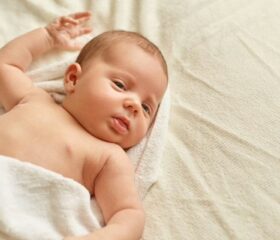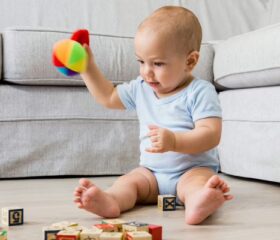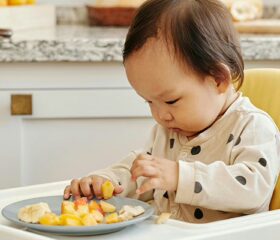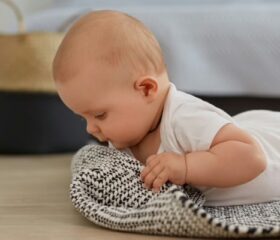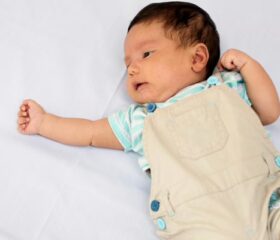What Is Baby Acne? Causes, Symptoms, and Treatments
Those tiny bumps on your newborn's face might have you doing a double-take. Is it a rash or an allergic reaction? It could simply be baby acne.
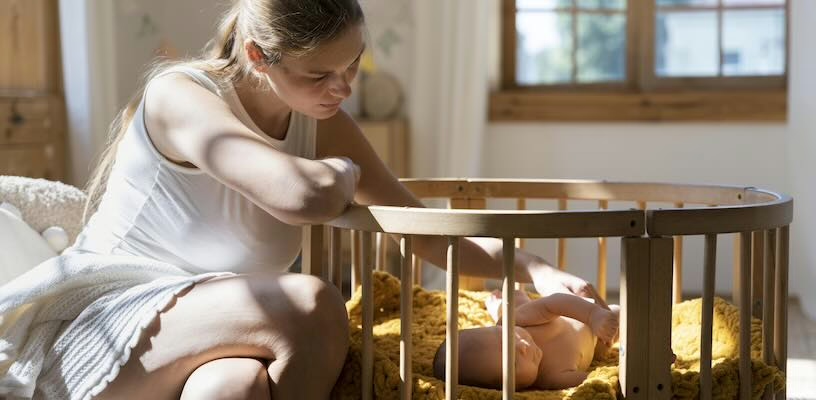
While it can be alarming to see pimples on your child’s brand-new skin, baby acne is a common and usually harmless condition.
Here’s everything you need to know about what baby acne looks like, what causes it, and how to treat it.
What is baby acne?
Baby acne, also known as neonatal acne or neonatal cephalic pustulosis, affects around 20% of newborns, especially baby boys. 1 Normally, it appears within the first six weeks of life, although it’s also sometimes present at birth. 2 3
The acne might get worse when your baby is around 4 weeks old (1 month old). However, by the time she’s 4 months to 6 months old, her acne will probably naturally fade without any special treatment from your doctor. 4 5
Note that baby acne is generally harmless and probably won’t cause your baby any pain, itching, or discomfort. You’ll probably be more bothered by it than she is.
This type of acne is also completely unrelated to the possible acne she might (or might not) have when she’s a teenager. 6
What’s the difference between neonatal and infantile acne?
While baby acne can last up to six months, it usually clears up within a few weeks or months. 7 On the other hand, infantile acne appears on babies when they’re around 3 months old, and can last up to two years. It’s also less common than baby acne, affecting around 2% of babies. 1
In contrast to the small, short-lasting bumps caused by baby acne, infantile acne involves blackheads, whiteheads, and, in more severe cases, lumps or cysts that can sometimes leave scars. 4
While it’s hard to say how likely scarring is, it tends to be more of a problem when the acne is more severe or if your baby has darker skin. Fortunately, early treatment usually reduces the risk of scarring. 1
What does baby acne look like?
If your baby has acne, it will probably appear as small red or white bumps or pimples, sometimes surrounded by reddish skin.
Acne normally shows up on the cheeks, nose, and forehead, but you may also see it on her face, back, scalp, neck, and chest. 7
Don’t worry if you notice the acne “flaring up” more than usual when your baby cries or gets fussy. It’s completely normal. When she gets worked up, more blood flows to her skin, which can make acne look worse. 3 Once she settles down, it should look the same as before.
How to tell the difference between baby acne and a rash
Distinguishing between baby acne and other common newborn skin conditions can be tricky.
Check out the table below to distinguish baby acne from other common skin conditions: 5 8 9 10
| Type of skin condition | Appearance | Accompanying symptoms | Location | Treatment |
|---|---|---|---|---|
| Baby acne | - Small red or white bumps | - Usually no other symptoms | - Concentrated on the face | - Good hygiene - Usually clears up without intervention |
| Heat rash (miliaria) | - Small, pink, blotchy spots - Tiny bumps |
- Itching - Soreness |
- Upper chest and back - Neck fold - Around the hairline - Under diaper (Can also show up in other spots) |
- Dressing your baby in loose, breathable clothing - Cooler and less humid environments |
| Eczema | - Dry and scaly skin - Red or purplish (depending on skin color) |
- Itching - Soreness |
- Face - Scalp - Chest - Elbows - Knees - Diaper area |
- Moisturizing creams and ointments - May require medical attention (if severe) |
| Erythema toxicum | - Red and blotchy rash - Tiny white pimples in the center |
- Usually no other symptoms | - Face - Chest - Arms - Legs |
- Usually clears up without intervention |
| Milia | - Tiny white bumps (without redness) | - Usually no other symptoms | - Nose - Chin - Cheeks |
- Usually clears up without intervention |
| Contact dermatitis | - Red bumps or flat areas of irritated skin | - Itching - Soreness - Swollen skin - Bleeding skin - Oozing from rash |
- Area where skin had contact with an irritant (e.g., soaps, detergents, perfumes, or even grass) | - Corticosteroid cream or ointment (prescribed by doctor) - Antihistamines (prescribed by doctor) |
| Allergic reaction | - Hives - Redness - Swelling |
- Itching - Vomiting - Diarrhea |
- All over the skin | - Corticosteroid cream or ointment (prescribed by doctor) - Antihistamines (prescribed by doctor) |
Consult your doctor if you’re not sure whether you’re dealing with baby acne or another skin condition.
Remember that acne shouldn’t bother your baby. If it seems to cause pain or irritation, it’s definitely time to talk to your doctor.
What causes baby acne?
Your baby’s skin is much more delicate than yours. It’s thinner, more sensitive, and won’t fully develop a protective barrier until she’s 12 months old. 11 This makes her skin more reactive to:
- Yeast: Babies often experience an inflammatory reaction to a common type of yeast (Malassezia) on the skin, which may contribute to baby acne. 1
- Maternal hormones: During pregnancy, your hormones can pass to your baby through the placenta and stimulate her oil glands, which can lead to breakouts.
- Irritants: Since her skin is sensitive, it can react to anything that stays on it for too long, whether it’s food, spit-up, or drool. Oily skincare products that block pores can also be a culprit.
After around three months, your baby’s hormones may cause an overgrowth of oil glands, which can cause acne. However, this is usually classified as a type of infantile acne rather than baby acne. 4
How can you treat baby acne?
In most cases, baby acne clears up on its own without any treatment. In the meantime, you can ease it with simple home remedies like:
- Keeping your baby’s skin clean: One of the best things you can do is keep your baby’s skin clean. Once a day, cleanse the affected areas. Be gentle, and don’t scrub. Use warm water and mild soap, even when you’re just cleaning milk residue left on her face. 2 Once you’re done, gently pat the skin dry.
- Steering clear of potential irritants: Remember that irritants can also worsen your baby’s skin. If you suspect this is the cause, consider switching out your usual hygiene products with unscented, hypoallergenic bathing products, lotions, and laundry detergents.
- Keeping your baby cool: As mentioned, you may sometimes see a flare-up (heat rash) when your baby gets too hot. To prevent this, try to keep her cool and avoid dressing her too warmly.
Consider recording any changes in your baby’s acne in a baby tracker app so that you can narrow down any suspected irritants or causes.
Be careful about using breast milk to treat baby acne
A lot of moms swear by dabbing a bit of breast milk on baby acne. The theory behind this is that the antibacterial and anti-inflammatory properties in your milk can alleviate skin problems. Unfortunately, while research does suggest breast milk may be helpful for treating eczema and diaper rashes, there isn’t research that backs up its use for acne. 12
What not to do about baby acne
Again, your baby’s skin is much more delicate than yours, making it more prone to irritation. Keep that in mind before reaching for any adult acne products you have lying around—these (and over-the-counter acne medications in general) are way too harsh for her skin.
Avoid oils or heavy creams that can clog her pores and make her acne worse. Even baby oils or ointments can worsen her acne. 5
Don’t pick or squeeze her acne. It might be tempting, but popping pimples can lead to infection or scarring.
When should you call your doctor about your baby’s acne?
Contact your pediatrician if your baby’s acne doesn’t clear up after a few months, shows up after your baby gets sick or takes medication, or looks like an allergic reaction (an itchy rash with hives).
You should also talk to your doctor if your baby shows signs of infection, such as: 6
- Pain, swelling, warmth, or redness around her rash
- Red streaks spreading out from the rash
- Pus leaking from the rash
- A fever
Your doctor can recommend treatment if necessary. In some cases, they may prescribe a mild topical cream.
Final thoughts
Although it may look alarming, baby acne doesn’t usually cause any problems for babies and often clears up by itself. The best thing you can do is keep your baby’s skin clean and keep an eye on it.
If it doesn’t seem to be getting better or you have any other concerns, don’t hesitate to reach out to your pediatrician.
Article Sources
- Canadian Medical Association Journal. "Infantile acne" Retrieved September 12, 2025.
- University of Rochester Medical Center. "Basics About Your Newborn Baby’s Body" Retrieved September 12, 2025.
- MedlinePlus. "Baby acne" Retrieved September 12, 2025.
- The Australasian College of Dermatologists. "Neonatal and infantile acne" Retrieved September 12, 2025.
- Seattle Children’s. "Newborn Rashes and Birthmarks" Retrieved September 12, 2025.
- MyHealth.Alberta.ca. "Learning About Rashes and Skin Conditions in Newborns" Retrieved September 12, 2025.
- ColumbiaDoctors. "Everything You Need to Know About Baby Acne" Retrieved September 12, 2025.
- Cincinnati Children's. "What Kind of Skin Conditions Can Newborns Have?" Retrieved September 12, 2025.
- Nemours KidsHealth. "Erythema Toxicum" Retrieved September 12, 2025.
- Stanford Medicine Children’s Health. "Contact Dermatitis in Children" Retrieved September 12, 2025.
- Melbourne School of Population and Global Health. "Common Infant Skin Rashes" Retrieved September 12, 2025.
- Nutrients. "Milk Therapy: Unexpected Uses for Human Breast Milk" Retrieved September 12, 2025.
